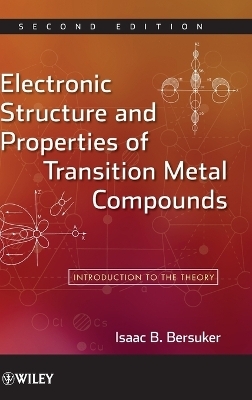
Electronic Structure and Properties of Transition Metal Compounds
John Wiley & Sons Inc (Verlag)
978-0-470-18023-5 (ISBN)
Isaac B. Bersuker, PhD, DSc, is a Senior Research Scientist and Adjunct Professor of Theoretical Chemistry at the University of Texas at Austin. He is a member of the Academy of Sciences of Moldova (former USSR) and the recipient of numerous awards, including the Medal of Honor (Republic of Moldova), David Ben-Gurion Medal (Be'er Sheva University), Chugaev Medal (Russian Academy of Sciences), and the 1979 State Prize Laureate (USSR).
Preface. Foreword to the First Edition.
Mathematical Symbols.
Abbreviations.
1 Introduction: Subject and Methods.
1.1 Objectives.
1.2 Definitions of Chemical Bonding and Transition Metal Coordination System.
1.3 The Schrödinger Equation.
Summary Notes.
References.
2 Atomic States.
2.1 One-Electron States.
2.2 Multielectron States: Energy Terms.
Summary Notes.
Questions.
Exercises and Problems.
References.
3 Symmetry Ideas and Group-Theoretical Description.
3.1 Symmetry Transformations and Matrices.
3.2 Groups of Symmetry Transformations.
3.3 Representations of Groups and Matrices of Representations.
3.4 Classification of Molecular Terms and Vibrations, Selection Rules, and Wigner-Eckart Theorem.
3.5 Construction of Symmetrized Molecular Orbitals and Normal Vibrations.
3.6 The Notion of Double Groups.
Summary Notes.
Exercises.
References.
4 Crystal Field Theory.
4.1 Introduction.
4.2 Splitting of the Energy Levels of One d Electron in Ligand Fields.
4.3 Several d Electrons.
4.4 f -Electron Term Splitting.
4.5 Crystal Field Parameters and Extrastabilization Energy.
4.6 Limits of Applicability of Crystal Field Theory.
Summary Notes.
Questions.
Exercises and Problems.
References.
5 Method of Molecular Orbitals and Related Approaches.
5.1 Basic Ideas of the MO LCAO Method.
5.2 Charge Distribution and Bonding in the MO LCAO Method and the Case of Weak Covalency.
5.3 Methods of Calculation of MO Energies and LCAO Coefficients.
5.4 Semiquantitative Approaches.
5.5 Semiempirical Methods.
5.6 Fragmentary Calculations, Molecular Mechanics, and Combined Quantum/Classical (QM/MM) Modeling.
5.7 General Comparison of Methods.
Summary Notes.
Exercises and Problems.
References.
6 Electronic Structure and Chemical Bonding.
6.1 Classification of Chemical Bonds by Electronic Structure and Role of d and f Electrons in Coordination Bonding.
6.2 Qualitative Aspects and Electronic Configurations.
6.3 Ligand Bonding.
6.4 Energies, Geometries, and Charge Distributions.
6.5 Relativistic Effects.
Summary Notes.
Exercises and Problems.
References.
7 Electronic Control of Molecular Shapes and Transformations via Vibronic Coupling.
7.1 Molecular Vibrations.
7.2 Vibronic Coupling.
7.3 The Jahn-Teller Effect.
7.4 Pseudo-Jahn-Teller Effect and the Two-Level Paradigm.
Summary Notes.
Exercises and Problems.
References.
8 Electronic Structure Investigated by Physical Methods.
8.1 Band Shapes of Electronic Spectra.
8.2 d –d, Charge Transfer, Infrared, and Raman Spectra.
8.3 X-Ray and Ultraviolet Photoelectron Spectra; EXAFS.
8.4 Magnetic Properties.
8.5 Gamma-Resonance Spectroscopy.
8.6 Electron Charge and Spin Density Distribution in Diffraction Methods.
Summary Notes.
Exercises and Problems.
References.
9 Stereochemistry and Crystal Chemistry.
9.1 Definitions. Semiclassical Approaches.
9.2 Vibronic Effects in Stereochemistry.
9.3 Mutual Influence of Ligands.
9.4 Crystal Stereochemistry.
Summary Notes.
Exercises and Problems.
References.
10 Electron Transfer, Redox Properties, and Electron-Conformational Effects.
10.1 Electron Transfer and Charge Transfer by Coordination.
10.2 Electron Transfer in Mixed-Valence Compounds.
10.3 Electron-Conformational Effects in Biological Systems.
Summary Notes.
Exercises and Problems.
References.
11 Reactivity and Catalytic Action.
11.1 Electronic Factors in Reactivity.
11.2 Electronic Control of Chemical Activation via Vibronic Coupling.
11.3 Direct Computation of Energy Barriers of Chemical Reactions.
Summary Notes.
Questions and Problems.
References.
Appendixes.
Answers and Solutions.
Subject Index.
Formula Index.
| Verlagsort | New York |
|---|---|
| Sprache | englisch |
| Maße | 158 x 239 mm |
| Gewicht | 1157 g |
| Themenwelt | Naturwissenschaften ► Chemie ► Anorganische Chemie |
| Technik ► Maschinenbau | |
| ISBN-10 | 0-470-18023-4 / 0470180234 |
| ISBN-13 | 978-0-470-18023-5 / 9780470180235 |
| Zustand | Neuware |
| Haben Sie eine Frage zum Produkt? |
aus dem Bereich



